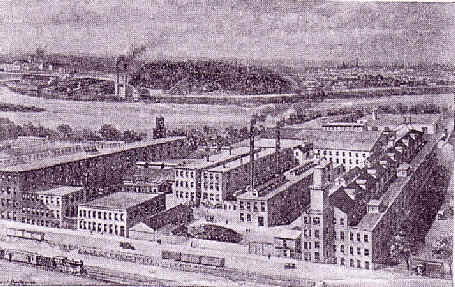William Adams Textile Manufacturing Chronology
by William Adams Hunter
- 1826 – William Adams immigrates to New York City
- 1829 – William Adams opens handloom in attic at West 4th Street
- 1832 – Formal business is started with a few handlooms at Waverly Street
- 1840 – Constructed building at No. 28 Perry Street to meet expanding business needs
- 1848 – Open salesroom at No. 38 Cedar Street, managed by Henry Adams at 12 years old
- 1857 – Robert & Henry Adams are admitted to partnership
- 1857 – Partners purchase and occupy Harmony Mills in Paterson, New Jersey with 60 hands
- 1859 – Moved Dyeing and finishing departments from New York to Harmony Mills
- 1862 – Firm organized under the name of William Adams & Co.
- 1863 – Built a three-story extension on the rear, ninety-five feet deep
- 1864 – William Adams retires at the age of 59 years
- 1864 – Firm reorganized under the name of R. & H. Adams’ Mosquito-Netting
- 1865 – Robert & Henry buy their father out of the business
- 1869 – The entire Harmony Mill is burned to the ground at a loss of $100,000, had employed 250 hands
- 1869 – Rebuilt Harmony Mills, forty-five by one hundred and ninety-feet, three stories high
- 1870 – Purchase the old Essex Mill on Mill Street, just above Boudinot, and extended the buildings
- 1874 – Built a store-house, twenty-five by ninety feet, five stories high on Mill Street, opposite the Essex Mill
- 1875 – The finishing house at the Harmony Mill was burned down, and was immediately replaced with brick
- 1876 – Added silk manufacture, first time fabrication of goods from two chief textiles, cotton and silk
- 1877 – Purchased the old Industry Mill property, adjoining the Harmony Mill and replaced it with a brick building
- 1878 – Workers strike lasted seven months
- 1879 – Robert Adams sells out his interest in the Paterson Mills to Henry
- 1880 – Robert Adams builds a water-powered mill in Shelton, Connecticut under the name of Adams Manufacturing Company . The plant is known locally as the Derby Cotton Mills, and was located on Canal Street, north of Bridge Street.
- 1890 – Henry Adams dies, R. & H. Adams, along with Paterson Mills are sold-off per his Last Will & Testament
- 1903 – Shelton Mills “living from hand to mouth” in wake of a major coal strike in Pennsylvania (Bituminous Coal Scare)
- 1904 – Robert Adams dies and leaves management of the firm to his son Robert Franklin, stock ownership divided to children
- 1906 – Large addition to the Shelton plant
- ???? – Robert Adams purchased cotton mill in North Scituate, Rhode Island
- 1915 – Rhode Island legislation creates reservoir for Providence, which condemns North Scituate cotton mill
- 1923 – Adams Manufacturing Co. purchased Nightingale-Morse Mill in Putnam, Connecticut and invested $100,000
- 1923 – Robert Franklin Adams dies suddenly at this home in Greenwich, Robert John is V.P. and Treasurer
- 1930 – Company liquidates Putnam factory
- 1937 – Adams Manufacturing files for bankruptcy
- 1938 – Robert John Adams dies suddenly at his home in New York City
- 1939 – Fire destroys 3 four-story buildings of the Shelton complex
- 1940 – Fire destroys one of the remaining five-story buildings at Shelton
- 1942 – The city of Shelton obtains title to the Putnam Mill in foreclosure action and sells it for $15,000
- 1989 – The remaining former Adams mill building in Shelton burns down in an accidental fire.

Connecticut Mills:
–Putnam Mill – Weave material
–Shelton Mill – Finished material
Shelton Mill capacity:
–17,000 spindles, 300 looms for $350,000 products per year
Paterson Mill capacity:
–Essex Mill – 17,032 spindles, 315 looms
–Harmony Mill – 9024 spindles, 314 looms
–Industry Mill – 8416 spindles, 200 looms
Paterson Mill Management:
–Sole Proprietor – Henry Clay Adams
–General Manager – William Adams, son of Henry Clay Adams
–Superintendent – Thomas Abbott
Posted in Historical Essays
